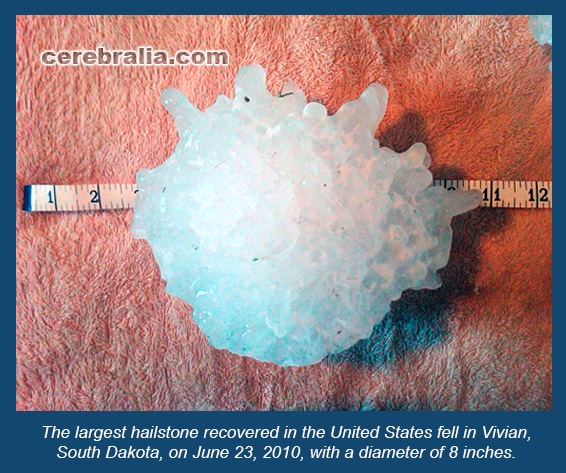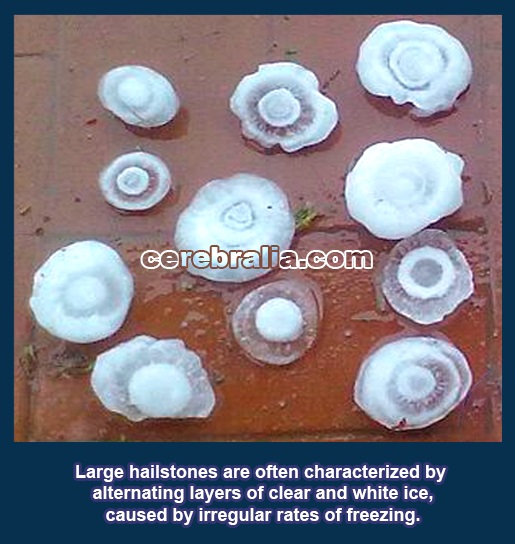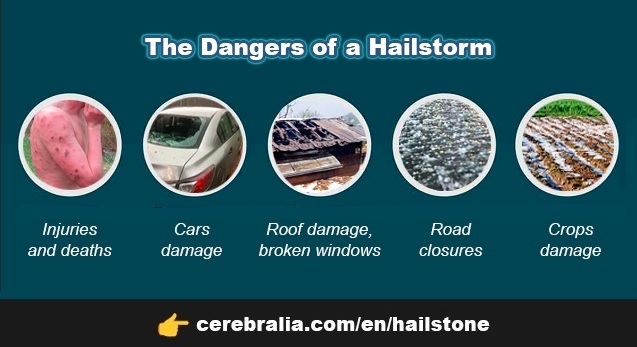Share on:
What is hail?
Hail is a form of precipitation consisting of solid ice that forms inside thunderstorm updrafts. Hail can damage aircraft, homes and cars, and can be deadly to livestock and people.
How does hail form?
For the hail formation, following conditions are necessary:
- Firstly, there must be a thunderstorm cloud (cumulonimbus cloud).
- Secondly, the upper portion on the cloud should be below freezing temperature.
- Thirdly, the cloud should have a great vertical height.
- Fourthly, it should have high water content.
- Lastly, there must be strong uprising winds called updrafts.
Hail begins to form when upfradts lift upwards the water droplets present at the bottom of the cloud. Now, as they ascend the freezing temperatures causes the droplets to turn into tiny hailstones.
Hail begins to form when updrafts lift upwards the water droplets present at the bottom of the cloud. High up in the cloud, the air is very cold and the water drops there freeze into ice. That makes them heavier and so they start sinking again.

Farther down, the ice graints hit the water drops there. They stick to the ice grains and make them grow a bit more. Strong updrafts lift the hail back up so that it can fall again, allowing more layers of ice to accumulate on the hailstone's surface.
This may happen several times, making the hailstone grow larger each time. The longer a strong updraft is present, the bigger the hailstone may become.
Eventually, the hailstone becomes too large to suspend in the air, or the updraft weakens, allowing the hailstones to fall toward the ground.
Hail sizes
When hail is 1 inch in diameter, that's the same size as a quarter and also when hail size is considered «severe» (or large enough to potentially cause damage).
In the strongest supercells that produce some of the largest hail one might expect to see 2 inches to 4 inches in diameter.

The largest hailstone ever measured in the U.S. was 8 inches in diameter in Vivian, South Dakota, on June 23, 2010. It weighed 1 lb 15 oz.
White ice and clear ice
Large hailstones are often characterized by alternating layers of clear and white ice, caused by irregular rates of freezing.

In areas where the temperature is not far below 0 °C (32 °F), freezing occurs slowly, allowing trapped air to escape and producing clear ice. When the hailstone then moves into a much colder area, freezing occurs quickly, trapping air and producing a layer of white ice.
Counting the layers of clear and milky white ice gives an indication of how many times the hailstone traveled to the top of the storm.
How fast does hail fall?
The fall speed of hail primarily depends on the size of the hailstone, the friction between the hailstone and surrounding air, the local wind conditions (both horizontal and vertical), and the degree of melting of the hailstone.

For small hailstones, ə inch in diameter, the expected fall speed is between 9 and 25 mph.
For hailstones that one would typically see in a severe thunderstorm (1-inch to 1.75-inch in diameter), the expected fall speed is between 25 and 40 mph.
In the strongest supercells that produce some of the largest hail one might expect to see (2-inches to 4-inches in diameter), the expected fall speed is between 44 and 72 mph.
It is possible for very large hailstones (diameters exceeding 4-inches) to fall at over 100 mph.
Why Does it Hail in Summer?
Hail is most common in mid-latitudes during early summer where surface temperatures are warm enough to promote the development of intense thunderstorms with strong updraughts and the upper atmosphere is still cool enough to support hail growth, and the upper atmosphere is still cool enough to support ice.
This is why it can still hail in the summertime, the air at ground level may be warm, but it can still be cold enough higher up in the sky.
In winter, showers and thunderstorms don't have the same strong updrafts as early summer storms, so the hail tends to be smaller in size.
The Dangers of a Hailstorm
Hailstorms with powerful winds and large hailstones can be highly damaging to plant and animal life. Some of the effects of hailstorms are:

- A hailstorm is extremely hazardous for aircraft, which can be seriously damaged if caught in the middle of a severe hailstorm.
- Driving during a hailstorm can be extremely dangerous, visibility is reduced during a hailstorm and roads become slippery.
- Hailstones can easily penetrate through glass-roofed structures or skylights. The metallic bodies of automobiles can also get dented by hail. A severe hailstorm can lead to economic losses in terms of damage to buildings and vehicles.
- Perhaps one of the most destructive effects of hailstorms can be observed on farms. A hailstorm with powerful winds can physically damage crops across large areas.
- Hailstones of significant size can kill people and animals who are unable to find cover during a hailstorm. Massive hailstones are known to cause fatal head trauma or concussions.
- very large hailstones may cause injury or death to animals or humans. Massive hailstones are known to cause fatal head trauma or concussions.
What to do during a hailstorm
- Avoid lone trees, flagpoles, telephone poles, fences and antennas.
- Stay indoors and away from windows, glass doors and skylights.
- Avoid using or touching electric appliances. Do not shower or wash dishes.
- If you are driving, pull over to the side of the road and turn on your hazard lights.
- Remain in your car with the windows and doors closed.

